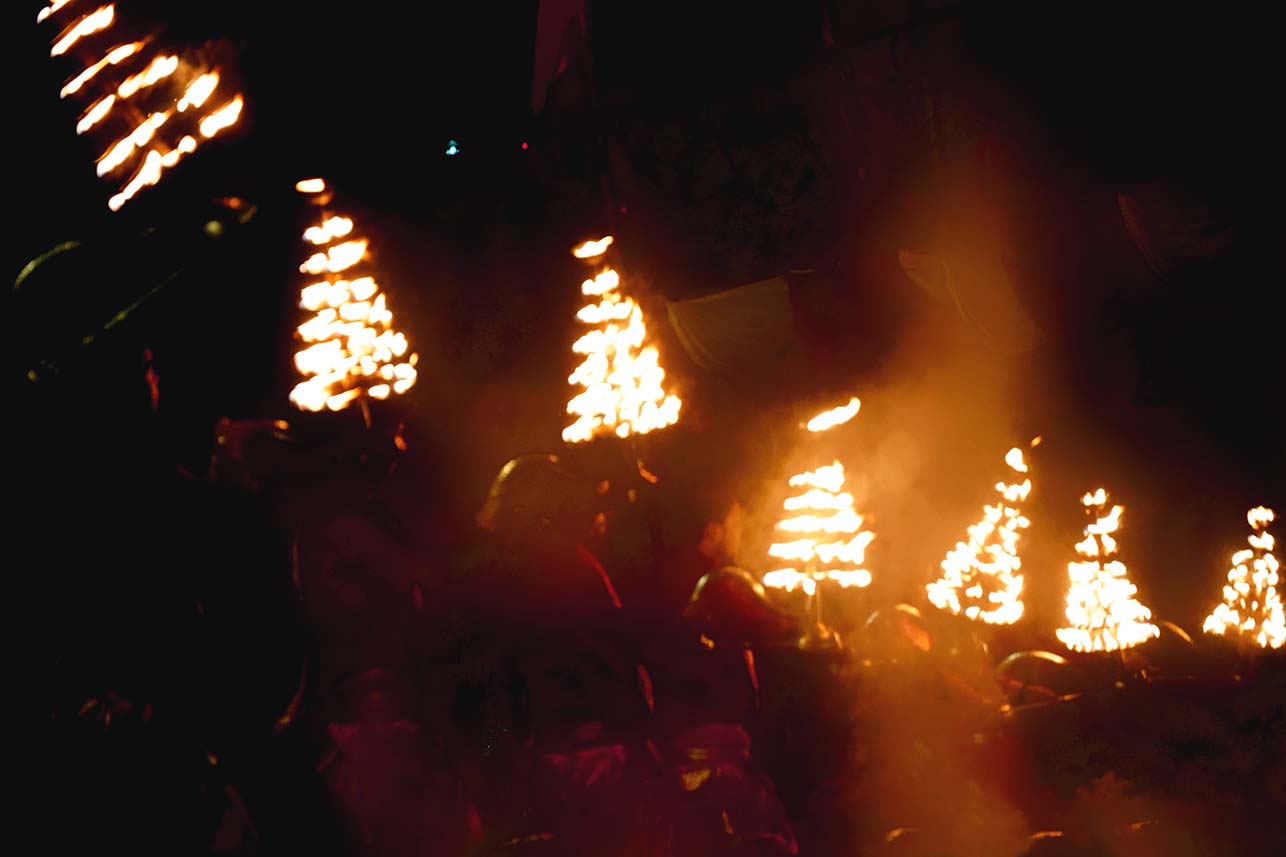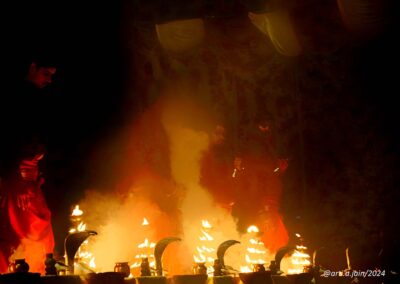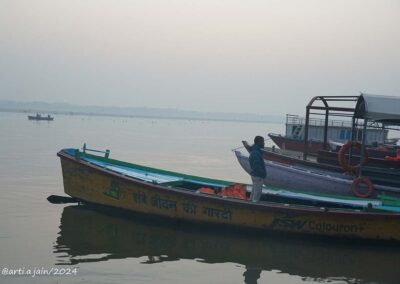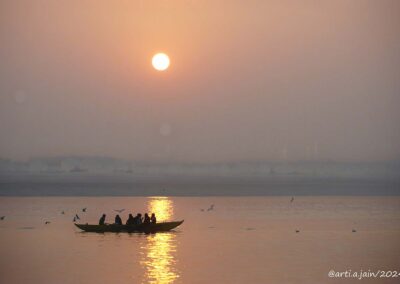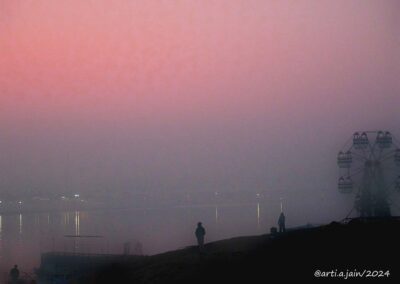Subah Banaras, shaam Banaras
Rehta har dum jam Banaras
Morning Banaras, evening Banaras
Stuck forever in a jam (traffic) Banaras
Khatt-khatt-khattak—khatt-khatt-khattak—the rhythm of the train, a lazy sun, trees, shrubs, grass—snuggled, smothered under winter fog, soft and surreal—sprawled across the window—came to an elaborately drawn-out noisy halt at precisely ten a.m.
The punctuality of our train’s arrival as it pulled into Banaras Railway Station surprised me, impressed me. The journey had been comfortable, too. Ritu, my friend, and I had arrived for our first ever Banaras trip to attend the Mahindra Kabira Festival. We’d planned to explore the city and its weavers for a couple of days before the festival started.
Outside the station, noise, crowds, enquiries: You want taxi? Auto? Where do you want to go? The shrill cacophony of the train station cracked the day open with the unpretentious aliveness evident in every town and city in India. I didn’t mind. The dialect of Hindi that was being tossed around sounded sweet, familiar and friendly.
In Banaras, the singular first person pronoun ‘mein’ (I in English) becomes ‘hum’ (plural we) and the harsh-to-my-ears ‘tu’ (you) is given a delicate and elegant makeover. It becomes ‘aap’. (‘Tu’ and ‘aap’ are to Hindi what ‘tú’ and ‘usted’ are to Spanish.)
To my ears, mein and tu sound divisive—like a cleaver chopping one into many. Hum and aap sound like a river—flowing with many currents, distinct but together, like a jugalbandi (a duet) of melodious flavours.
The taxi driver who drove us through Banaras’s jam-packed streets spouted poetry to quell our queries about how long it would take to reach our hotel.
Subah Banaras, shaam Banaras
Rehta har dum jam Banaras
Morning Banaras, evening Banaras
Stuck forever in a jam (traffic) Banaras
I slid back deeper into the car seat and started feasting my eyes upon street scenes outside: rambunctious, chaotic, but running as smoothly as a well-rehearsed ballet. Life-affirming, energetic scenes, I mused, especially if like me you’ve travelled from a pristinely immaculate and shiny city like Doha.
The next day, we got even more stuck. And this time, it was our fault. Or rather, the fault of Google Maps. It led our driver into a lane that wasn’t designed for cars. In fact, the lanes (gullian) of Banaras have little to do with planned design. They are veins and nerves, crisscrossing the city with such ferocity and abandon that if I were drunk on bhaang (an intoxicating cannabis drink Banaras is famous for), I’d see them as a metaphor for this Universe—vibrant and elusive but tick-tocking precisely to the pulse of time, space and matter.
Stuck in the middle of a milieu of hand-pulled rickshaws, tempos and bikes, I witnessed Banaras live up to its name—ready-made juice/nectar. Comfort came from the unlikeliest of sources.
Only when one is stuck in a car in a jam created by the car one is stuck in, does one understand the laws of physics properly. No matter how much we would’ve liked to, the car’s solidity couldn’t be molded to squish past every conceivable obstruction of urban India. There were massive milk containers laden on bicycles and motor bikes, horses dressed to the nines in red and gold finery for a wedding or a procession, tempos teaming with teenagers, motorbikes parked in front of shops, construction material piled up by the lane-side and gossiping groups of bystanders filling any gaps in the crammed space.
Every obstruction gaped at us like problems in a trigonometry text book. You had to solve the first to move to the next before you could move on. You had to find a way.
But there was no way. We were stuck. We couldn’t turn around or even reverse the car out. The lane behind, and in front, was choked.
Even the bystanders looked aghast at our stupidity.
“Wah! Yeh kaun gyani log gaadi le aaye yahan? Samajhdaar maloom padte hain.” (Who are these learned ones who’ve brought their car here? They seem wise.) A man quipped through his paan stuffed mouth as he dismounted from his scooter, jammed behind our car, to move his vehicle to the side somehow and took charge of the situation.
Despite his sarcasm, he managed to move a few obstructions. I was thankful. So, I smiled my thanks to him. He caught my eye and simply shook his head in disbelief.
Our cool as a cucumber driver inched forward very, very gingerly. He asked for guidance from the people around. No one had ever seen a car in this lane, they said. Ab jo hoga, bhaiya, wahi hoga. Whatever will be, will be.
I was too busy focusing on the micro minutes of being stuck to wonder how we’d find our way out. I opened my channel of inner dialogue with Krishna (like I do when I’m in a fix). It calms me. It focuses me.
Comfort came from the most unexpected of sources. It came from everyone around us. In that chaotic, turbulent scene, every rickshaw puller, tempo driver and onlooker became a saathi, a sehyogi (helper). Left ko kato, turn the wheel to the left, halt! Men of all shapes and sizes, ages, Hindus and Muslims alike, guided our driver to somehow maneuver through that lane. Inch by dreadful inch, with the help of these angel-guides, we finally managed to reach the main road. It took us a total of 40 minutes to traverse half a kilometer! Not one angry outburst. Not one. What surprised me the most was the fact that everyone who helped us, without a single exception, was worried that the car should not get scratched. They were able to offer us comfort despite the fact that our ‘stupidity’ had caused a major jam in their day.
This is Banaras, as is. No feel-good posters, no romantic notions, no ancient wisdom or medieval poetry to lure the traveler. Just a lived experience of a people who I believe are the legacy of this land of poets and philosophers, musicians and seekers.
There was none of the anger, the frustration, the rage that one would see on the streets of any other city.
However, if you’re planning to visit this city, I’d suggest you avoid the streets and explore as many of the 84 ghats (flight of steps leading down to a river) by the Ganga as you can.
Every day that I was there, I’d wake up early to catch the morning aarti (Hindu ritual where oil lamps and incense are offered to gods amidst hymns) on Assi Ghat and as soon as the sun was up and the aarti ceremony was over, I’d start my exploration of the ghats.
Life and death, the living and the newly dead share space on the banks of the Ganga in Banaras. The continuously burning pyres at Manikarnika Ghat resonate with Kabir’s poetic reminder—die every day to live fearlessly, to sing boundlessly.
The ever-present reminder of one’s mortality is the best antidote to anxiety. I see my end in front of me. So, why not live this moment with every ounce of my being? In the hum of ‘hum—aap—aap—hum’ of Banarasi boli (dialect) lies the essence of this mind-bogglingly amazing city.
More than four weeks have passed but the virah (the longing) for Banaras is still as potent. What is it about this ancient living city that has held me in its grip? I’m trying to figure it out by reliving some of the memories of a five-day-visit as I sift through the photos I took.
It’s late afternoon in Doha. I’ve spread a chatai (straw mat) on the grass under our neem tree. The three p.m. January sun is playing holi with the bougainvillea blooms. They shimmer pink, orange, white and turn so saturated with light that the wind chime, moving to the beat of a gentle breeze, hum-hum-hums from another world—hum—aap—hum—mingles with the inside—the outside. I’m back on the ghats, looking into a sunrise colouring the calm waters of the Ganga in slow motion. There’s no rush. Whatever will be, will be.
The title of Linda Hess’s book that I’ve been devouring like an obsessive lover fits the scene like a glove—‘Singing Emptiness’ sits on the chatai. Suddenly, I have an urge to listen to Kumar Gandharva’s rendition of ‘Udd jayega’ one more time. Like a fool, I break the magic of the moment and play it on my phone. His voice starts weaving another web of escape. I surrender. And dissolve.
These photographs are an attempt to revisit a feeling that has no word/words (that I know of) to describe it. It’s as simple as love, as potent as virah and as old as hiraeth.

